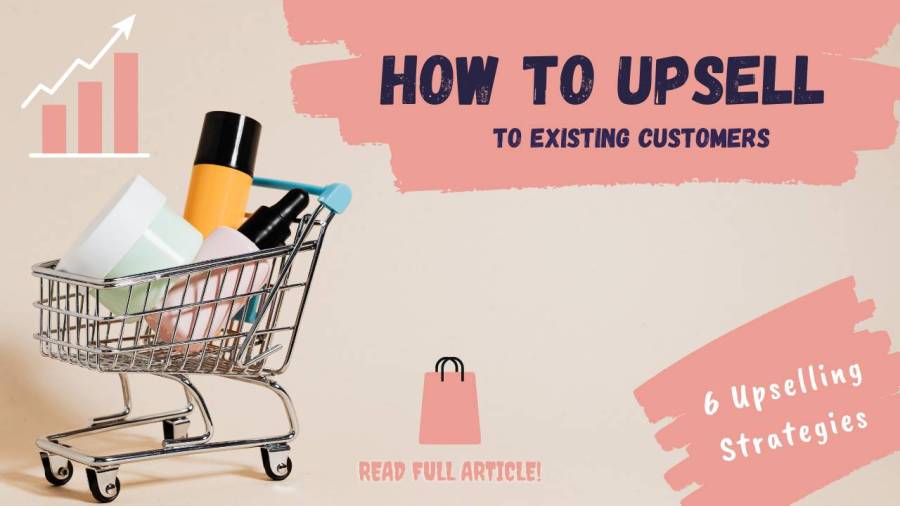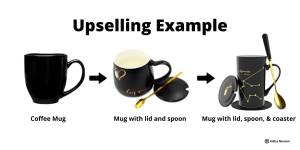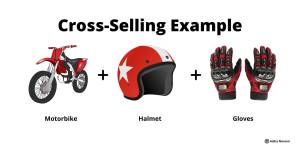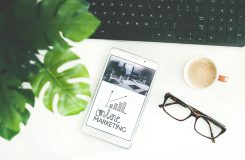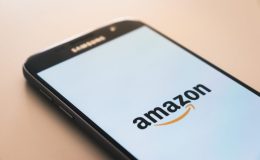Upsell to Exiting Customer, Strategies Explained: Did you know it costs five times more to acquire a new customer than it does to sell an existing one? Well, as digital marketers, we know the pressure of producing results with a limited budget. So, we grab every opportunity to maximize sales, brand loyalty, and customer retention.
Upselling and cross-selling are such opportunities that produce promising results without drenching you in a heavy sweat. In 2021, more than 60% of experienced sales leaders used upselling and cross-selling techniques to achieve their goals.
So, whether you’re a small e-commerce store, or a large corporation, trying to market your B2B company or working in the B2C spectrum, you can hugely benefit from upselling and cross-selling.
Not sure how to get started? This guide will show you six tested upselling strategies with examples, so you can start increasing your average order value and rise above the bottom line while retaining your existing customers.
What is upselling?
Upselling is the act of persuading a customer to purchase a more expensive or upgraded version of a product or service. It also includes selling add-on features to a product or service.
For example, let’s say you own a home goods store, and a customer is interested in buying a coffee mug. You might convince them to buy a more expensive mug that includes matching teaspoons and coasters. This is called upselling.
Upselling can also involve convincing a customer to purchase an upgraded version of a product or service. For example, ask a customer who is using the basic version to purchase the premium version of the software that includes more features.
What is Cross-Selling?
Cross-selling involves selling anything that complements or adds value to a primary product or service. In contrast to upselling, the secondary product or service is not a more expensive or upgraded version of the same thing. Still, it is relevant to the primary product or service.
For instance, if you are selling a motorcycle, the customer may also be interested in buying a helmet and bike gloves. Now the helmet and gloves are not the upgraded or more expensive version of the motorbike but are relevant to the primary product. So selling such relevant items is called cross-selling.
You have seen large eCommerce stores such as Amazon, Etsy, eBay, etc., upselling by showing relevant items to your searched items. This cross-selling technique has increased 35% of Amazon’s revenue. But did you know upsells are 20x more effective than cross-sells? So, let’s learn why, when, and how to upsell to existing customers.
Why should you upsell?
There are several reasons why you dedicatedly put your efforts into upselling your existing customers. Some of the reasons are listed below:
Boost Sales
Upsell can help you boost your average order value. Studies show that upselling can increase your revenue by up to 30%. If you’re able to upsell to even a tiny percentage of your customers, it can have a big impact on your bottom line.
Increase Customer Retention, Satisfaction, and Loyalty
Upselling can also help you increase customer satisfaction, retention, and loyalty. If you upsell a customer a better quality product, they will likely be more satisfied with their purchase. And if they’re happy with their purchase, they’re more likely to come back and buy from you again in the future.
Upselling is Cost Effective
Upselling costs you less as it is 68% more affordable than acquiring a new customer. So, by putting in a little effort and investment, you can gain big with upsells.
When Should You Upsell?
The best time to upsell is when a customer is already interested in buying a product or service. Since the customer is already in need and wants the best thing, selling an expensive and upgraded version is easy.
For example, a customer wants to buy a TV and is considering multiple options related to screen size, warranty, and other features. It’s a good time to try to upsell them to a more expensive one with a larger screen, an extended warranty, Wi-Fi options, screen recording, etc. Since the customer is already interested in buying a TV, they will be more likely to be receptive to your upsell.
Another good time to upsell is when a customer is about to make a purchase decision. If they’re wavering between two different products, you can try to upsell them to the more expensive option.
You should also be aware of any red flags indicating a customer is not interested in an upsell. For example, if a customer seems rushed or impatient, it’s probably not a good time to try to upsell them.
Moreover, if a customer clearly communicates to you a specific budget, don’t annoy them by persuading them to spend more.
How to Upsell to Existing Customers Effectively
Now that you know when to upsell, it’s time to learn how to upsell effectively. Here are six strategies you can use to upsell your customers:
1. Identify the Right Customer – Set Criteria to Make Upsell Relevant
If you try to upsell randomly, it may alarm your customers of your saleziness. Not every customer is going to be interested in the upsell, so it’s important to identify the right customer.
The buyer’s persona helps you identify whom to target for a specific product or service. Since you are targeting customers who have already purchased from you, go through the feedback and suggestions you obtained from them from the last purchase. You can use customer relationship management (CRM) software to track customer preferences and make targeted recommendations.
You can also use demographic and psychographic information obtained from SERP and other analytical tools, such as Google Analytics, to study your customer’s interests and preferences. Then using this data, you can upsell to your customer by customizing it to the customer’s interests.
For example, suppose you sell home goods, and someone is interested in a new set of pots and pans. You know from the data or conversation with the customer that they are also looking for a healthy lifestyle and diet plan. You might upsell them to a set of pots and pans specially designed for healthy cooking. This upsell is relevant to the customer because it’s something they’re interested in, and they easily pay for more expensive utensils.
2. Offer a Discount on the Upsell
All customers like sales, gift items, or free trials. So, one way to make an upsell more appealing is to offer a discount on the upsell. This can be a percentage discount, a free trial, or a gift with purchase.
For example, let’s assume you are selling business formation services in 3 plans: Silver, Gold, and Platinum. The price and features increase from Silver to the Platinum plan, and data shows that your customers found features of higher plans appealing. By giving a slight discount on the Gold and Platinum features, you can encourage your customers to subscribe to the more expensive package to start their business.
You may also give some incentives with higher plans or expensive products. For example, a customer is looking for bath towels. A more absorbent and higher quality fabric containing a small gift or free item such as a kitchen towel will more likely appeal to your customers, even if it is more expensive.
You may also offer free shipping with the upgraded versions of products. Research shows that 75% of U.S customers expect free shipping. This is why many sellers put a price limit on free shipping to compel customers to purchase more expensive products just to get free shipping.
3. Demonstrate the Benefits With Evidence
When you’re trying to upsell, it’s important to demonstrate the benefits of the product you’re trying to upsell. After all, why would someone pay more for something that does not seem to offer more or add more value?
The best way to do this is to use evidence and scientific data. For example, if you are selling software and the clients are using the basic version, you can show them the benefits of the premium version they are missing out on. You can also give them case studies to prove how customers with upgraded versions gained more success.
Social proof is also a powerful persuasion technique to demonstrate the benefits of premium products. This technique involves using the endorsements of other people to convince someone to take action. Clients’ testimonials and influencers can play a vital role in this perspective.
In such scenarios, your previous customers, influencers, and research speak on your behalf and influence your customers’ decision-making.
4. Use Scarcity or Urgency
Another way to make an upsell more appealing is to create a sense of urgency or scarcity for upgraded versions of products and services. Scarcity is a technique that causes your customer to perceive that there’s a limited supply of products, so they should purchase them before someone else does.
Research proved that customers perceive scarce products as more valuable. Many brands use the scarcity technique to sell expensive goods. While shopping, we often encounter such phrases as “Limited edition” or “only a few items left.” How compelled do we feel seeing such phrases with our favorite items?
Urgency is a time-based strategy through which you can develop a fear of missing out in your customers. Research shows that around 56% of customers fear missing out when you apply the urgency technique. Since the product or offer is available for a short time period, this compels the customers to buy within the limited time constraints.
The urgency techniques are usually exercised during special days and festivals. You can also use this tactic within a few days of purchasing the basic version of services. This urgency will make the customer more likely to take up your upsell offer.
5. Send a Follow-Up Email or Text
It is always desirable to follow up with your customers after they have made a purchase. It does not only help you improve your products and services but also improves customer satisfaction. So, follow-up emails and texts will also encourage your customers to purchase from you again in the future.
In addition to that, follow-up emails or texts help you know whether your clients or customers would like to upgrade or not. The best time for upselling email or message is:
- After a purchase: “Would you like to add extra cheese or salad in your sandwich?” is a classic upsell right before the sale closes.
- When a user hits a milestone: When your customers hit a milestone or anniversary, you may upsell by offering a more advanced solution.
- At the end of a free trial: Mostly, SAAS and services upsell emails come at the end of a free trial. Persuading customers at this time helps customers to subscribe to a paid plan.
- When the client is about to reach account limitations: You can send upsell emails when a user is nearing account limitations. Gaming subscriptions, data packages, and writing software are a few examples that use upsell email near account limitations.
- When you launch a new product: If you have launched an upgraded version of a software or service, you must send an upsell email to the customers using the previous versions.
6. Personalized Customer Services
Your customers should never feel that upselling is just a money grab. You need to convince them that you’re presenting the best solution for their needs, problems, or challenges. While, as a marketer or seller, you take the time to get to know your customers, it is essential that your customers also know your efforts.
By providing your customers with knowledgeable and friendly customer service, you let your customers know how much you care about them. The customers feel that you understand their needs and desires by talking to customer care representatives.
Customer support can make specific recommendations for products or services that seem a good fit for the specialized circumstances of customers. When customer service representatives explain why they are making the recommendation and how an upgraded version would benefit the customer more, customers are likely to convert to the upsell.
Note: You can use many of the strategies mentioned above to cross-sell and acquire new customers.
Conclusion
To increase sales, businesses often try to reach new customers. While this is certainly important, it’s also essential to focus on upselling to existing customers. After all, it’s easier and more cost-effective to sell to someone already familiar with your product or service.
Upselling not only increases your revenue but also increases customer satisfaction. We all know happy customers are more likely to spread the word about your business. So, upselling also helps acquire new customers. Try these upselling strategies and let me know which one of these six upselling strategies worked best for you.
Featured Image Credit: Provided by the Author; Thank you!
